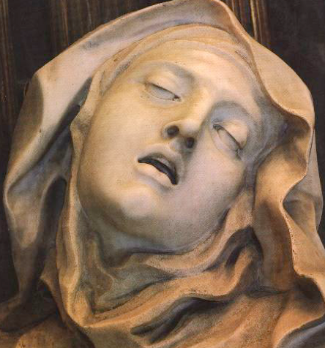Both the monotheistic and the pagan god are defined as love. However, unlike Yahweh’s, the love of a pagan god is exclusively erotic. And erotic means transgressive.
Think of Zeus, the head of the Greek Olympic pantheon. His innumerable affairs, both heterosexual and homosexual, the crowd of illegal sons and daughters he begot, the number of mortal hearts he broke: all this makes clear he can be considered as much the emblem of erotic love as is the love goddess’s son, Eros himself.
Attic red figure of Zeus and Aigina, ca 450 BC
Even more than Eros, Zeus shows the pagan divine love to be morally indifferent, if not simply ethically condemnable. The isle Aegina was depopulated, so a Greek myth tells, because Zeus’s wife Hera was angry at her husband having seduced the nymph Aegina (who had given her name to the island). And as often, Zeus had done his ‘thing’ by bluntly making misuse of his power. An Attic red figure shows him pursuing the nymph using his scepter as a lance.
When a pagan god loves you, things can end sad both for yourself and for others. Which implies that you should never take his divine behavior as a moral example. Certainly not in the case of Zeus’s sexual activities.
Ferdinand Bol, Aegina waiting for Zeus, ca 1650
And yet, Zeus’s acts are not without exemplary function. Take for instance one of the myths accompanying the birth of Alexander the Great. It tells that, in reality, Alexander is not the son of Phillip, the man of his mother and the king of Macedonia. It was Zeus who fathered him with Philip’s wife, Olympias. For that purpose, the Olympic god did not recoil from abusing even the religious feelings of his beloved/victim. Since Olympias was adherent to a holy snake cult, Zeus had taken the shape of a snake to seduce her. And during the moment suprême of his act, Zeus’s eagle was there to use the famous thunderbolt to blind the husband, who by accident or suspicion had entered the room.
In the Palazzo Te in Mantua (Italy), Giulio Romano has visualized the story in a fresco which is famous and infamous at the same time, if only because it is one of the few ‘pornographic’ images in Renaissance painting showing clearly an Olympic god in full erection. The large size of the fresco as well as its highly public place in the palazzo are remarkable, even for the ‘libertine’ Renaissance spirit of that time.
Giulio Romano, Jupiter seduces Olympias, 1526-1534
Zeus’s behavior is misleading and cheating. He is brutally mean, and his act is far from being an example to follow. And yet, that act nonetheless fully honors Alexander, both his nature and his power. He is born out of a divine, morally transgressive act . And this is why he is predetermined to be called ‘the Great’.
Is then the monotheistic God free from this kind of transgression? Not exactly. He, too, often takes position beyond the Law – the Law, by the way, he himself has laid on his people. But in the monotheistic texts, this transgression is never performed in the erotic sphere. Even when Yahweh commands his prophet to transgress the Law by marrying a prostitute, eroticism is never the end but always the mean of the action. In Hosea (1:2) we read that Yahweh said to his prophet: ‘Go, take to yourself a wife of harlotry and have children of harlotry; for the land commits flagrant harlotry, forsaking the Lord.’ Hosea is obviously not supposed to enjoy his acts. He only has to show how one should not act. His transgressive deed is a negative example. ‘Israel, you should not be unfaithful to me by worshiping other gods; see my prophet and you will realize what you are doing: you make love to prostitutes, to idols, while it is Me who is your One and Only God’, so Yahweh explains through Hosea’s acts.
Marriage of Hosea and the Prostitute, Bible of Saint André au Bois, Bibliothèque municipale de Boulogne sur Mer, 12th century
However, this One and Only God operates no less beyond the Law than did Zeus. But instead of the realm of erotic enjoyment, he enters the realm of mere violence. Yet, contrary to popular opinion which accuses the monotheistic God of immorality, one must stress that, here too, Yahweh’s transgressive violence is not meant as an example to follow. No one is God and, consequently, should act as if he is God. Yahweh’s transgressive acts is only meant to show where the Law has its base and origin. It allows a glimpse in what Blaise Pascal defined as the ‘mystic foundation’ of the law.
The ground of the Law is its beyond. The Law has its origin in freedom, i.e. in a position free from the Law. Both the pagan and the monotheist tradition acknowledge this. Yet, where monotheism considers that ‘beyond’ as agape, i.e. as love fulfilling all desire (and, consequently, destroying all that is left unfulfilled), paganism supposes that beyond as the realm par excellence of unfulfilled and unfulfillable desire, as eros.
Two kinds of love: love as eros, and love as agape. Two kinds of love corresponding two ways of defining the divine, of the realm beyond the Law at the same time founding that Law: on the one side the divine as explicit transgression, as lawless love beyond of any ethical norm; on the other side the divine as ‘solving’ that transgression and turning it in the realized aim of man’s ethical and existential drive.
That dichotomy is the secret heart that beats in our culture already from the fifth century onwards (the century in which Augustine’s amor combined eros and agape). It is a ‘secret’ beat, indeed, for though contradictory, both go together and hide their impossible ‘liaison’ behind the pink ‘cloud of unknowing’ in which all our discourses on love have bathed and still bathe.
*












































































